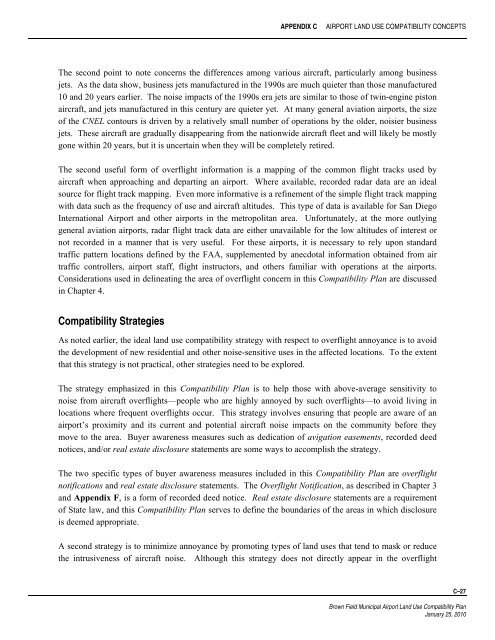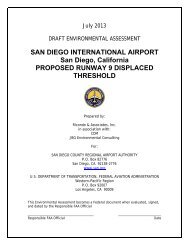Brown Field Municipal Airport Land Use Compatibility Plan
Brown Field Municipal Airport Land Use Compatibility Plan
Brown Field Municipal Airport Land Use Compatibility Plan
- No tags were found...
Create successful ePaper yourself
Turn your PDF publications into a flip-book with our unique Google optimized e-Paper software.
APPENDIX CAIRPORT LAND USE COMPATIBILITY CONCEPTSThe second point to note concerns the differences among various aircraft, particularly among businessjets. As the data show, business jets manufactured in the 1990s are much quieter than those manufactured10 and 20 years earlier. The noise impacts of the 1990s era jets are similar to those of twin-engine pistonaircraft, and jets manufactured in this century are quieter yet. At many general aviation airports, the sizeof the CNEL contours is driven by a relatively small number of operations by the older, noisier businessjets. These aircraft are gradually disappearing from the nationwide aircraft fleet and will likely be mostlygone within 20 years, but it is uncertain when they will be completely retired.The second useful form of overflight information is a mapping of the common flight tracks used byaircraft when approaching and departing an airport. Where available, recorded radar data are an idealsource for flight track mapping. Even more informative is a refinement of the simple flight track mappingwith data such as the frequency of use and aircraft altitudes. This type of data is available for San DiegoInternational <strong>Airport</strong> and other airports in the metropolitan area. Unfortunately, at the more outlyinggeneral aviation airports, radar flight track data are either unavailable for the low altitudes of interest ornot recorded in a manner that is very useful. For these airports, it is necessary to rely upon standardtraffic pattern locations defined by the FAA, supplemented by anecdotal information obtained from airtraffic controllers, airport staff, flight instructors, and others familiar with operations at the airports.Considerations used in delineating the area of overflight concern in this <strong>Compatibility</strong> <strong>Plan</strong> are discussedin Chapter 4.<strong>Compatibility</strong> StrategiesAs noted earlier, the ideal land use compatibility strategy with respect to overflight annoyance is to avoidthe development of new residential and other noise-sensitive uses in the affected locations. To the extentthat this strategy is not practical, other strategies need to be explored.The strategy emphasized in this <strong>Compatibility</strong> <strong>Plan</strong> is to help those with above-average sensitivity tonoise from aircraft overflights—people who are highly annoyed by such overflights—to avoid living inlocations where frequent overflights occur. This strategy involves ensuring that people are aware of anairport’s proximity and its current and potential aircraft noise impacts on the community before theymove to the area. Buyer awareness measures such as dedication of avigation easements, recorded deednotices, and/or real estate disclosure statements are some ways to accomplish the strategy.The two specific types of buyer awareness measures included in this <strong>Compatibility</strong> <strong>Plan</strong> are overflightnotifications and real estate disclosure statements. The Overflight Notification, as described in Chapter 3and Appendix F, is a form of recorded deed notice. Real estate disclosure statements are a requirementof State law, and this <strong>Compatibility</strong> <strong>Plan</strong> serves to define the boundaries of the areas in which disclosureis deemed appropriate.A second strategy is to minimize annoyance by promoting types of land uses that tend to mask or reducethe intrusiveness of aircraft noise. Although this strategy does not directly appear in the overflightC–27<strong>Brown</strong> <strong>Field</strong> <strong>Municipal</strong> <strong>Airport</strong> <strong>Land</strong> <strong>Use</strong> <strong>Compatibility</strong> <strong>Plan</strong>January 25, 2010
















